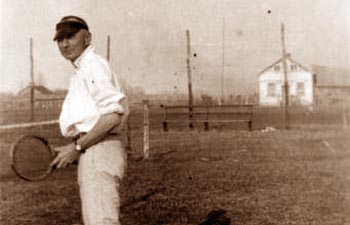November 5, 2013
The men and women who modeled medical practice and founded and developed the organization for the prevention of disease and forced treatment in a new country are worthy of remembrance.
Early life
Dr. Jamieson was the Ontario lightweight boxing champion before graduating in medicine from the University of Toronto and earning an MRCS (Member of the Royal College of Surgeons) in 1911. He was also an accomplished golfer, swimmer, figure skater, skier, dancer, marathon runner, badminton and tennis player, remaining active well into retirement.
Together with his brother, Claude, he toured Canada and settled in Edmonton in 1912.
At the University of Alberta
Dr. Jamieson joined the U of A faculty as a provincial laboratory bacteriologist. He helped draft the first medical curriculum in 1914.
During World War I, he replaced Dr. Allan C. Rankin as the acting head of the provincial laboratory. He also gave Dr. Rankin's lectures and taught the course in clinical medicine.
In 1918, he proposed a District Nurse program for Alberta, which began the next year, and later joined the provincial traveling clinic that went north every summer.
After Dr. J.B. Collip returned to the U of A from a sabbatical in 1921/1922, Drs. Collip and Jamieson presented a program, using the newly available insulin that Dr. Collip had isolated.
Future dean Dr. J.W. Scott attended the program, beginning his 48-year association with the U of A faculty of medicine. Dr. Jamieson also started an early diabetic outpatient program. His second patient didn’t see another physician for 20 years and the third lived until age 65.
By 1922, Dr. Jamieson had become an Assistant Professor of Medicine. At the time, a U of A teacher's medical income was only a supplement. Although Dr. Jamieson maintained a private practice that specialized in allergy, kidney and endocrine problems, he rarely sent out bills to his patients. Not infrequently Dr. Jamieson received Christmas presents from wealthier patients and chickens from grateful rural patients.
Literary life
In 1927, Jamieson and Dr. Richard K. Gordon of the U of A English department wrote two novels about the life of a boy in the Northwest Territories. They used a pseudonym (Norman Blake), to protect their reputations, and published the books in England.
Medical historian
Dr. Jamieson became a full-time teacher of medical history and ethics in 1928. By 1933, he had written histories of Dr. William M. Mackay, the Edmonton General Hospital and medicine in Edmonton. In recognition, the Jamieson Reporting Club was formed to focus staff and students on medical history.
Jamieson’s seminal book, Early Medicine in Alberta: The First Seventy-five Years, was published in 1947, the year he retired.
Always looking for adventure, he took up flying during his retirement. His instructor had trouble getting him to land, so he forced Dr. Jamieson to make his first landing by uncoupled his control column and throwing it overboard. He was horrified when Dr. Jamieson did the same thing.
Dr. Jamieson had learned about the plan beforehand, so he stored another control column under his seat. The landing was perfect, but his instructor didn’t speak to him again for three months.
Although he passed away in 1962, Dr. Jamieson’s papers were only discovered in a desk on the top floor of the U of A medical school in 1981. Their value was fortunately recognized. The deposition included 311 early medical photos and 79 lantern teaching slides. Visit the collection website.
